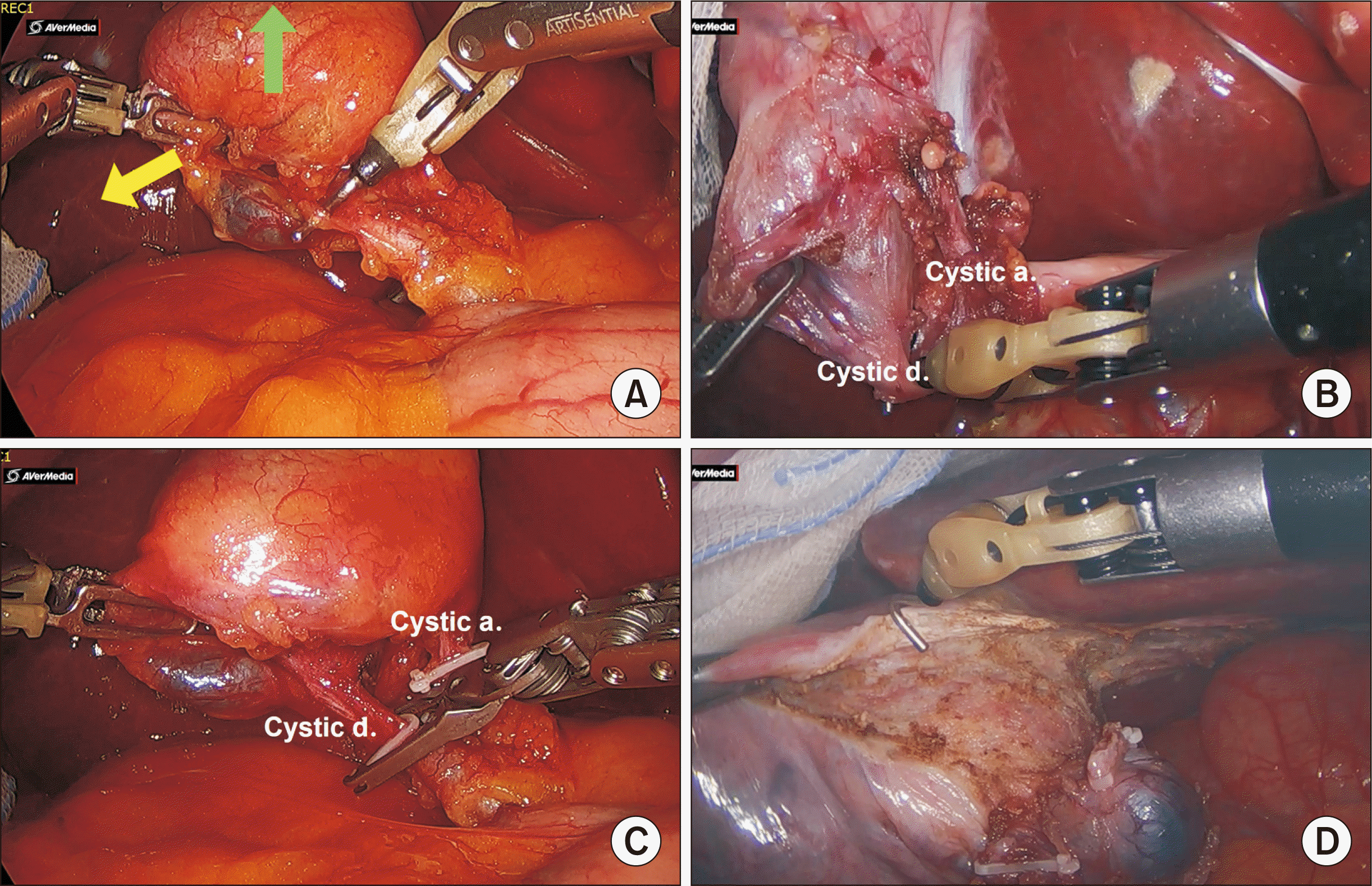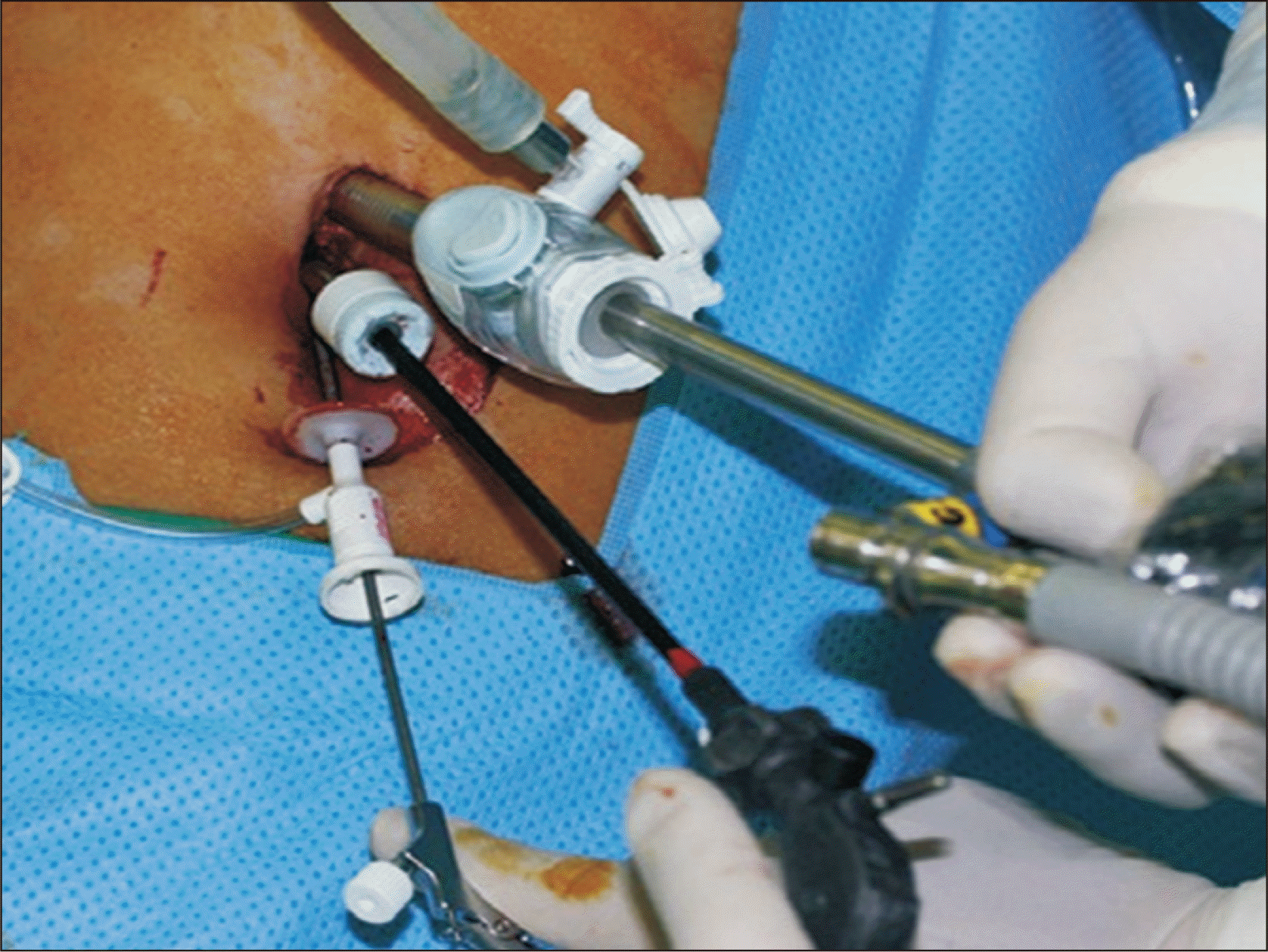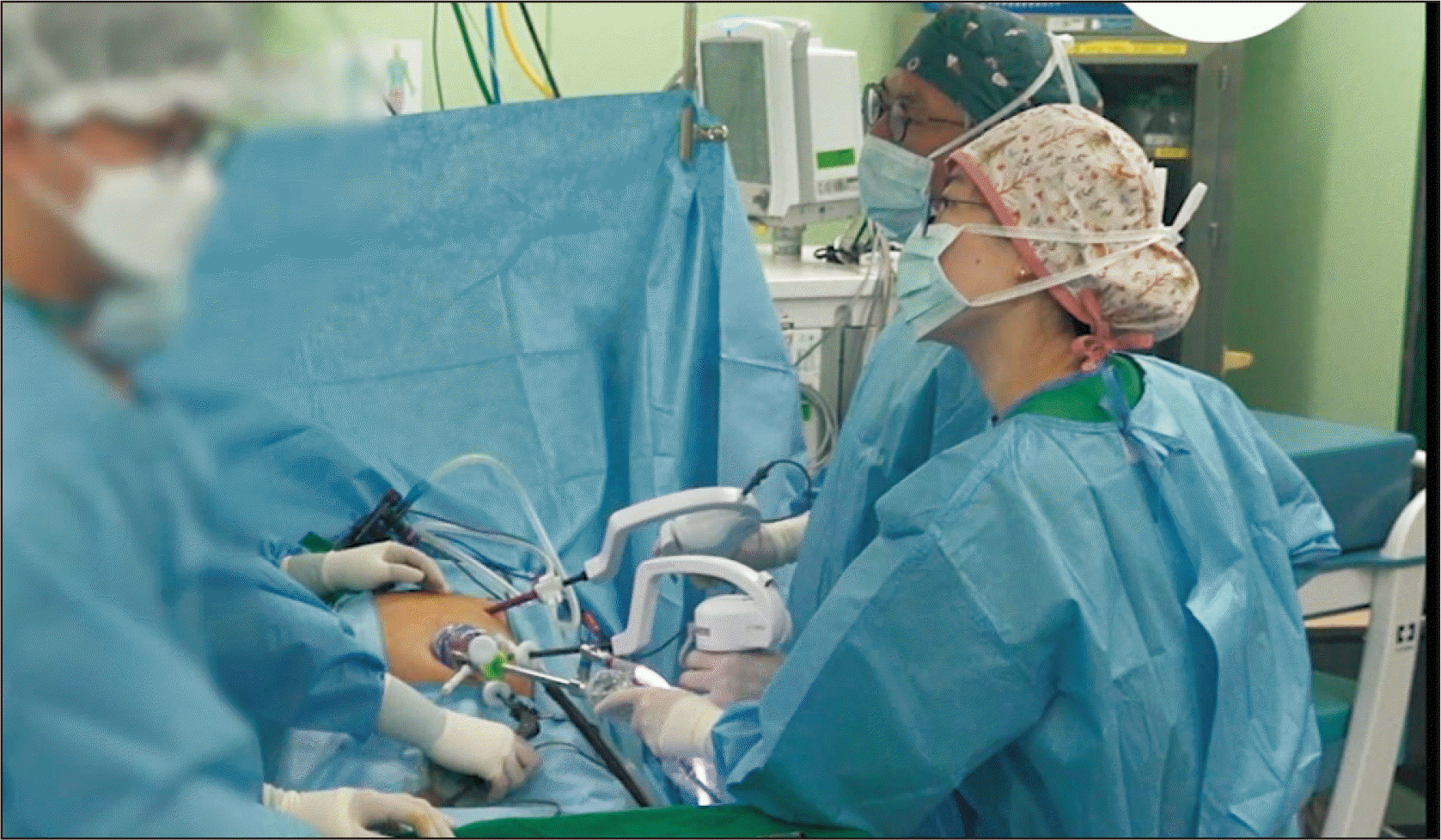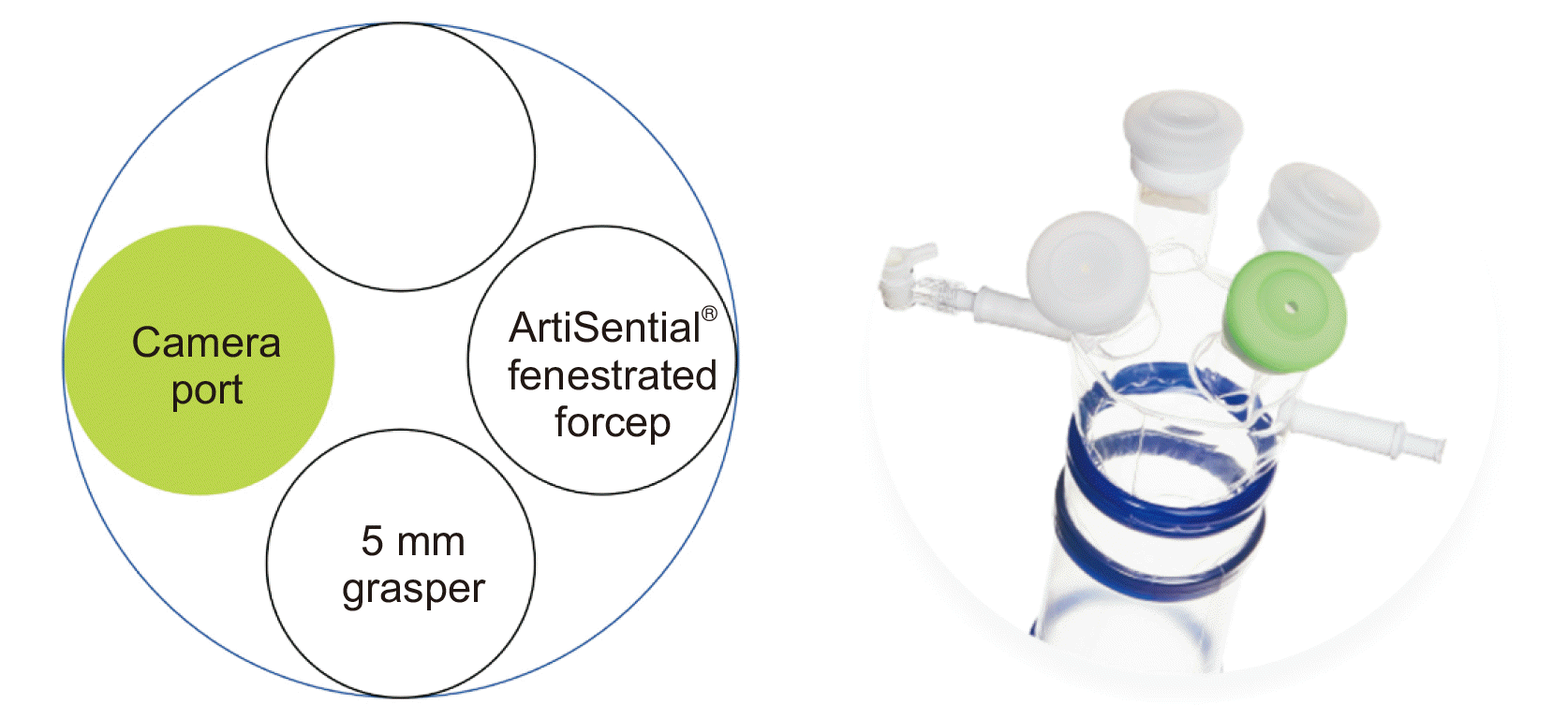INTRODUCTION
Laparoscopic cholecystectomy (LC) was first performed by Philippe in France in 1987, and has become the standard treatment method for benign gallbladder (GB) disease, such as symptomatic GB stones and GB polyps [
1]. Conventional LC (CLC) is typically performed through four ports, but continuous advancements have been made to reduce access injuries, improving cosmetic outcomes and postoperative recovery. Single-incision LC (SILC) is part of this effort. SILC has been shown in the literature to have several advantages over CLC [
2-
4]. However, due to the technical difficulties of SILC, several methods have been developed to overcome them [
5-
7], single-fulcrum LC (SFLC) being one of them. Previous studies have found that SFLC has shown better results for postoperative pain compared to CLC, with no difference in surgical outcome [
8,
9]. Nevertheless, SFLC has shown several drawbacks.
In recent years, robotic surgical systems for single-port laparoscopic surgery (e.g., Da Vinci SP) have been introduced to overcome the limitations of CLC and SILC, and have been widely adopted [
10,
11]. Although robotic surgery has many advantages, it also has limitations in terms of cost [
12]. The ArtiSential
® (LIVSMED Inc.) is a new multi-degree-of-freedom (DOF) articulated laparoscopic instrument that reflects the ergonomics of robotic surgery [
13]. This instrument can overcome the spatial limitations of laparoscopic surgery, especially those with fewer ports, such as single-port laparoscopy. In addition to LC, ArtiSential
® has been used in various procedures, including appendectomy, gastrectomy, and colon surgery [
14-
17]. ArtiSential
® LC (ALC) is a procedure that has recently been performed extensively in our center, and has evolved through trial and error into a single port +1 format. Moreover, no studies have reported LC using ArtiSential
®.
The present study aimed to introduce the ALC technique as practiced in our center, and to compare the surgical outcomes of ALC and SFLC.
Go to :

DISCUSSION
LC is widely performed as the standard treatment for benign GB disease, and the trend is towards less invasive procedures. As a result, minimally invasive LC procedures have been developed to reduce the number of incisions, and SILC has evolved in this regard, with several methods having been proposed [
2-
4]. Compared to CLC, SILC uses only one incision, which reduces postoperative pain compared to CLC, which requires multiple incisions; has advantages, such as faster recovery and fewer postoperative complications; and is known to provide patients with relative psychological satisfaction, due to fewer incisions and faster recovery [
5-
7,
21,
22]. SFLC, which has been introduced and implemented in our center, is one of these methods, and is a single-incision and multi-port technique that is performed by inserting three trocars into the fascia, with wide exposure of the fascia, after making a transumbilical incision. Compared to SILC, this technique has the advantage of being easier to perform due to less instrument collision; it also has a clear cost advantage [
8,
9]. However, the disadvantages of SFLC are that the main procedure is handled by the operator’s left hand, which can be a barrier for right-handed operators; and if the patient has an umbilical hernia, the fascia is not intact, which can cause intraoperative air leakage, and make the operation difficult. In addition, the frequency of intraoperative bile leakage was higher than in CLC.
The rise of robotic surgery since the 2000s has led to the introduction of robotic single-site cholecystectomy (RSSC), to overcome the spatial limitations of SILC. In RSSC, the movement of surgical instruments is relocated, allowing the surgeon to control the instruments intuitively and ergonomically through a single surgical site from a surgical console [
10,
11]. The advantage is that unnecessary movements due to hand tremors or the leverage principle are eliminated, allowing much greater freedom of movement in the abdominal cavity. However, the disadvantage of RSSC is its low cost-effectiveness, compared to other non-robotic LC surgeries [
23,
24]. Since RSSC has this cost limitation, several devices with articulation have been developed to realize the ergonomic advantages of robotic surgery in the laparoscopic setting [
25], and ArtiSential
® is one of them. ArtiSential
® is a single-use, articulated, multi-DOF surgical instrument, and the world’s only low-cost, hand-held surgical instrument that combines the main advantages of robotics: the articulated structure of the forceps and their intuitive manipulation [
13]. Since its introduction in 2019, ArtiSential
® has been applied in a variety of surgeries, and is especially effective in surgical methods with space limitations, such as single-port laparoscopic surgery. It can be applied to SILC, a representative single-port laparoscopic surgery, and through several trials and errors, our center has developed and applied an effective ALC method for both surgeons and patients.
In this study, patients who underwent LC for uncomplicated GB stones were studied, and the ALC group had a lower postoperative pain score and a lower frequency of intraoperative bile leakage compared to the SFLC group, while there was no significant difference between the two groups in other surgical outcomes, such as operative time, EBL, and length of stay. As a result, when comparing the two minimally invasive techniques, ALC was found to be a better surgical procedure for patients. The reason for the pain score being significantly lower in ALC compared to SFLC is thought to be due to the number of fascia incisions and more fascia exploration for exposure in SFLC. Also, in SFLC, monopolar cauterization was used diffusely to control the bleeding focus in the liver bed, but in ALC, bipolar fenestrated forceps were used to cauterize only the bleeding focus area, which may have contributed to the difference in pain. In addition, the intuitive control provided by the articulation and ergonomic design of ArtiSential® also benefits the operator, allowing for precise and controlled manipulation during dissection around GB, reducing the likelihood of unnecessary trauma to surrounding tissues, which can help alleviate postoperative pain. Although we used an additional 8-mm trocar in the ALC, the pain scores were low even in this situation, and as 5-mm instruments are expected to be available soon, we expect that with a smaller incision size, the pain will be even lower.
The incidence of intraoperative GB rupture was also lower with ALC. GB rupture during cholecystectomy is associated with increased postoperative pain due to bile spillage and potential peritoneal irritation [
26]; therefore, the lower incidence of GB rupture in the ALC group may be associated with lower postoperative pain scores. In addition, previous literature has reported a poor prognosis for intraoperative GB perforation in patients with GB malignancy [
27]. This suggests that patients with suspected GB malignancy, such as large polyps, can be safely operated on with ALC. Although this study was conducted in patients with uncomplicated GB stones, the multi-joint, multi-DOF features of the ArtiSential
® can be used to safely perform surgery in complicated GB disease. In fact, our center has safely performed with ArtiSential
® many cases of partial cholecystectomy for severe cholecystitis.
The disadvantage of ALC is that it is cheaper than RSSC, but more expensive than SFLC. Since SFLC uses most of the equipment of CLC, the cost is almost the same as that for CLC; however, ArtiSential® is relatively expensive, since the price of the instrument is higher than those of laparoscopic instruments. In addition, ArtiSential® has the disadvantage that the learning curve can be long, as surgeons may be confused when they first encounter ALC, since it combines the fulcrum principle of laparoscopic surgery and the intuitive movement of robotic surgery in one instrument. Finally, the large size and weight of the instrument can make it difficult for surgeons with small hands or limited strength to use it effectively. Nevertheless, as mentioned above, while ArtiSential® has many advantages, fully realizing these benefits will require significant effort from surgeons to understand and master its characteristics. With this dedicated effort, we think that the clinical application of ArtiSential® could serve as an alternative to robotic surgery in the future.
There are several limitations to this study that should be considered. One limitation is the different time periods over which data were collected for the ALC and SFLC groups. These temporal differences may have introduced variability in surgical techniques, advances in devices, and postoperative care protocols, which could independently affect outcomes. Another limitation is that the different time periods resulted in a somewhat different group of surgeons who performed the surgeries. However, since this study compares the experience of a single surgeon who developed different surgical approaches, including both early and advanced experience with each approach may reflect a more balanced view of outcomes, minimizing the impact of differences in surgeon proficiency. To further reduce bias and increase the validity of our findings, we used PSM analysis to minimize potential confounders. This approach helps ensure that differences in observed outcomes are more likely attributable to the surgical method itself, rather than differences in patient population, or the period of surgery.
To the best of our knowledge, this is the first study of LC with ArtiSential®, and it confirms that a less invasive and cosmetic LC can be performed safely and efficiently with ArtiSential®.
In conclusions, ALC has been shown to be a safe and effective treatment for benign GB disease. It has also been shown to have significant advantages over SFLC, particularly in terms of postoperative patient pain. By utilizing the features of ArtiSential®, it is expected that the indication for surgery can be expanded to include complicated GB disease, and that it can be safely operated.
Go to :






 PDF
PDF Citation
Citation Print
Print







 XML Download
XML Download